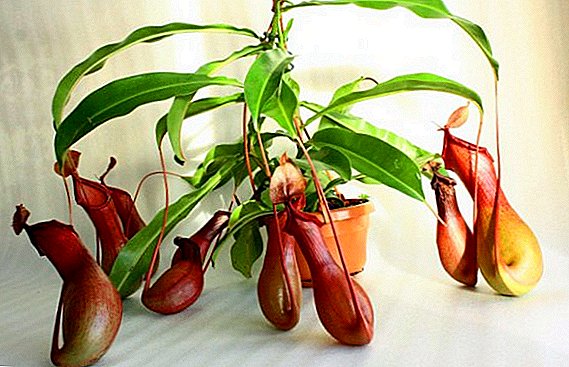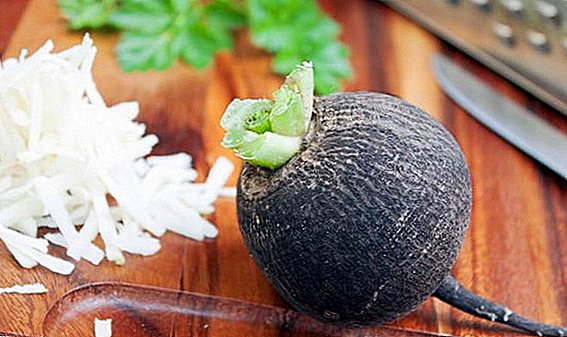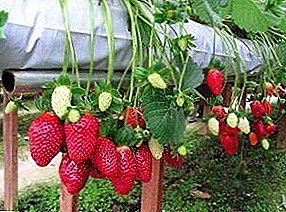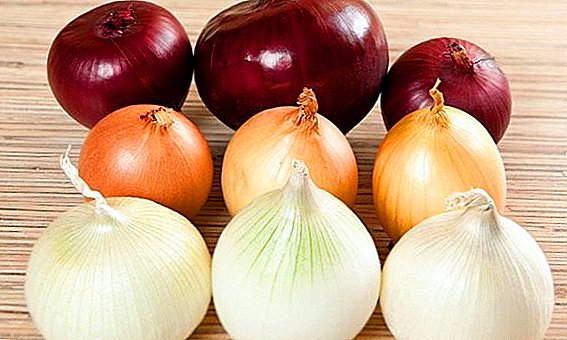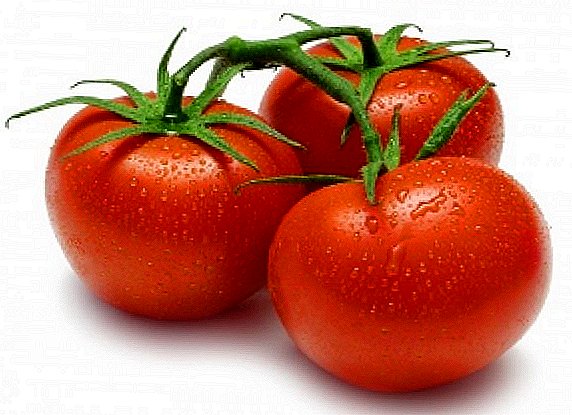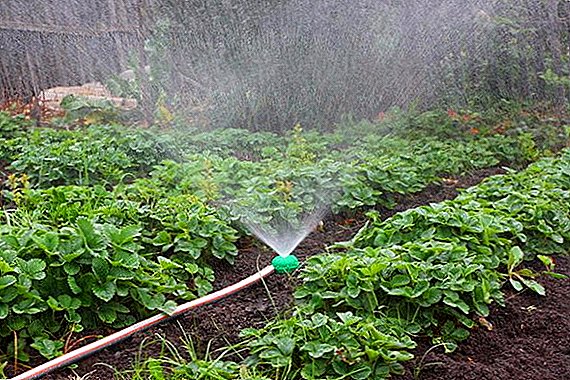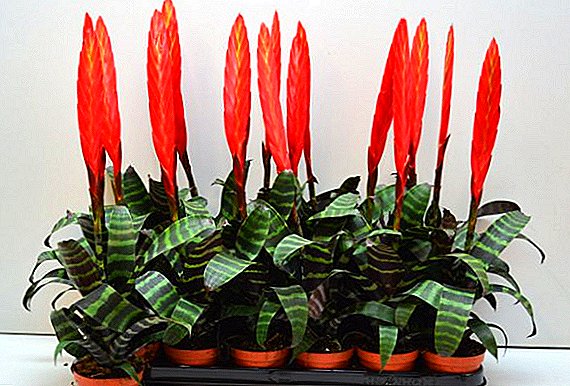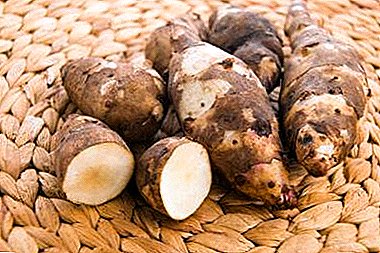
Jerusalem artichoke is a very beautiful, tall plant, with huge yellow flowers that look like sunflower flowers. It is unpretentious and grows very quickly.
The fruits of the plant resemble potato tubers. It is actively used in food. There are many recipes for the preparation of earthen pear.
But in order to use it not only in the autumn, but also in the winter, you need to know how to properly preserve its fruits. After all, they must not only not lose their appearance, but also preserve useful properties. How to implement the storage will be described below.
When to dig it up?
One of the important factors of cultivation and obtaining a good rich harvest of any crop is to meet the timing of harvesting. Jerusalem artichoke can be safely held in the ground until the end of autumn.
Reference! The earth pear is a frost-resistant plant and easily transfers frosts to 20 degrees.
Interestingly, many gardeners leave the plant in the ground until spring. Why is this happening? When should you dig the crop for storage?
Tubers of this plant resemble potatoes in their appearance and taste.. Therefore, many consider them interchangeable. The fruits of Jerusalem artichoke are stored in the ground, even in very cold weather. It is enough for gardeners to cover the beds with grass, and they will last until spring.
If you plan to remove half of the fruit for storage, and leave the rest in the ground, the stems should be cut. They do this just before the frosts and leave a height of about 20 cm. Tubers are dug out after a couple of weeks, during which time their yield may even increase.
Those who left part of the crop in the ground before spring should have time to dig them up with the first sun. Otherwise, if the earth has time to warm up, the tubers will sprout and become not so tasty and healthy. There is another problem - rodents. By spring, they can spoil the crop left in the ground.
Why is it important to comply with optimal conditions?
 Each method of storage of Jerusalem artichoke, whatever you choose, has its own characteristics. The most important parameters are temperature and humidity. Jerusalem artichoke does not like heat and sun. Direct sunlight kills tubers. It is also important to maintain high humidity so that the fruit does not dry.
Each method of storage of Jerusalem artichoke, whatever you choose, has its own characteristics. The most important parameters are temperature and humidity. Jerusalem artichoke does not like heat and sun. Direct sunlight kills tubers. It is also important to maintain high humidity so that the fruit does not dry.
When stored in a cellar, it must be poured with sand, or stored in boxes. Jerusalem artichoke should not be laid on a concrete floor, otherwise it will immediately lose all moisture and spoil. The safety of fruits and their beneficial properties will depend on how precisely the storage conditions will be observed.
Is there a difference in safety at different times of the year?
At any time of the year, storage of Jerusalem artichoke in an apartment, cellar, or refrigerator will not be long. It is stored for a relatively short time.. Only freezing and drying of fruits will prolong its safety. Therefore, it does not matter whether the harvest will be harvested in the autumn or in the spring. It will be stored equally. If it is possible to leave the tubers in the ground, then it is better to take advantage of this and get topinambur as needed.
Ways to ensure freshness of fruits at home
There are several ways that allow you to save the fruits of Jerusalem artichoke. Every way is good enough. But the ideal option is still keeping the tubers in the ground. Unless, of course, allows the climate in which you live.
How to store in the winter in the cellar?
What is good in terms of storage basement? This method does not require much time and effort, but the shelf life in it will be small.
There are several options for keeping the Jerusalem artichoke in the cellar:
- Use the place where you store carrots.
- Put the Jerusalem artichoke there and sprinkle with sand.
- Do not separate dug tubers from each other.
- Without shaking them off the ground, place them in a suitable container.
- Put topinambur in ordinary boxes: wooden, plastic, which you will find. Cover with moss, sawdust or peat on top.
- Lubricate the tubers with clay and let dry. Place in a bag and tie tightly so that less air is left.
- Place the tubers in bags of earth.
- Each root can be treated with paraffin. To do this, they need to be dipped in melted paraffin wax, allowed to dry, then put into the basement.
From time to time check that the crop does not rot. It is important to observe the temperature regime not higher than 5 C. In the cellar it can be stored for no longer than a month.
Do not store Jerusalem artichoke next to potatoes and beets.
Can I freeze at home in the freezer?
 The advantages of this method are that you do not need to think that the skin of the fetus will suffer. There are no shortcomings in the storage of topinambur frozen.
The advantages of this method are that you do not need to think that the skin of the fetus will suffer. There are no shortcomings in the storage of topinambur frozen.
Before placing it in the freezer, you should clean the fruit. Cut them in the way you want to eat it comfortably. The sliced fruit can be placed in plastic bags or in containers. Due to the fact that the plant tolerates low temperatures well, it will retain its beneficial properties even when frozen. Thawing Jerusalem artichoke should be in cold water, in order for this process to be gradual.
The freezer will allow to keep fruits up to three months.
Drying
The advantages of this method of storage include the fact that all the beneficial properties of the plant are preserved. Although many mistakenly believe that after drying, the tubers lose them. Difficulties can arise only at the preparation stage.. Use a ceramic knife for cutting, the metal oxidizes the tubers. Remember that Jerusalem artichoke does not like direct sunlight, so you need to store it only in a dark place.
Dry chopped tubers can be in the oven or outdoors, in the shade. Stored dried Jerusalem artichoke for several months, if not violated conditions.
Waxing
This method allows tubers to remain juicy for a long time.. It is very important to do the procedure of waxing quickly, as the Jerusalem artichoke does not tolerate overheating.
- Tubers should be cleaned from the ground very carefully, without damaging the skin.
- A little dry.
- In the prepared paraffin, lower the tubers and leave them to dry. The procedure should be carried out in a cold room so that the fruits quickly cool and do not overheat. Otherwise, it will be disastrous for the earthen pear.
- Next, the tubers can be placed in the basement in boxes, or left in an apartment in a cool place. They will be stored no more than a month.
Natural shelter in the ground
Storing Jerusalem artichoke in the ground is the most successful of all ways.. In the ground, it will continue until spring. The disadvantages of this method are that if you live in a climatic zone where it is very cold and the earth freezes deeply. It will be difficult to dig it when the need arises.
Cover for the winter fruit can be grass, cardboard, plywood. In March, it is already possible to dig the remaining crop, as with warming the tubers will start to produce new shoots.
Trench method
 This method is suitable for those who have no place to store it in the house, there is no cellar or place in the refrigerator, for example.
This method is suitable for those who have no place to store it in the house, there is no cellar or place in the refrigerator, for example.
Storage in trenches is an approximation to the natural conditions in which topinambur grows. The disadvantages are rodents, which can penetrate the trenches and spoil the harvest.. In this case, you can put poison, or next to the tubers lay burdock inflorescences.
The trench should be prepared in the fall, until the ground is soft enough. Its depth should reach 50 cm. The bottom is covered with straw or sawdust. Good, intact fruits are placed on the bottom of the pit and covered with earth, sand, straw. Cover the film and poured another layer of earth.
The earthen pear will be kept until spring.
How to understand that the fruits are spoiled?
Understand that the fruits have deteriorated by external signs and smell:
- fruits dried, ceased to be juicy;
- tubers are blackened;
- there is no smell;
- mold has appeared;
- green and black spots appeared on frozen tubers;
- the fruits that were stored in bags, they became unsteady and a fungal plaque formed on them;
- tubers rotted.
You should not eat Jerusalem artichoke with the above signs.
There are many ways to keep Jerusalem artichoke in the winter at home. Everyone can choose the most convenient and suitable for the shelf life and complexity of preparation. Properly preserved topinambur strengthens health, saturates the body with micronutrients and vitamins that it needs, especially in winter.


